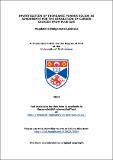Files in this item
Investigation of inorganic porous solids as adsorbents for the separation of carbon dioxide from flue gas
Item metadata
| dc.contributor.advisor | Wright, Paul Anthony | |
| dc.contributor.author | Lozinska, Magdalena Malgorzata | |
| dc.coverage.spatial | 252 | en_US |
| dc.date.accessioned | 2013-08-16T09:06:56Z | |
| dc.date.available | 2013-08-16T09:06:56Z | |
| dc.date.issued | 2013-07-25 | |
| dc.identifier | uk.bl.ethos.577294 | |
| dc.identifier.uri | https://hdl.handle.net/10023/3964 | |
| dc.description.abstract | Porous inorganic solids including mesoporous silicas, zeolites and silicoalumnio-phosphates have been investigated as adsorbents for carbon dioxide, particularly in relation to uptake from flue gases at 0.1 bar and ca. 298 K, but also at higher pressures. The mesoporous silicas SBA-1 and SBA-2, with mesocages separated by narrower windows, have been prepared, calcined at various temperatures and also nitrided with ammonia at high temperature. Nitridation has resulted in framework nitrogen incorporation, but this gave only small increases in the uptake of CO₂ of these mesoporous silicas, which are very low (< 0.2 mmol g⁻¹) at flue gas conditions (0.1 bar, 298 K). A series of cationic forms of the small pore zeolites, chabazite, ZK-5 and Rho, have been prepared by exhaustive cation exchange (and pre-calcination of the as-prepared form of Rho). In addition, a series of ultrastabilised zeolite Rho samples has been prepared to investigate the influence of extra-framework aluminium species on CO₂ uptake. For comparison, the silicoaluminophosphate versions of ZK-5 (SAPO STA-14) and Rho (SAPO(RHO)) have been prepared. Adsorption on Li-, Na-, K- and Ca-forms of chabazite (Si/Al = 3.0) has been related to the crystal structures of their dehydrated forms, as determined by Rietveld refinement against powder X-ray diffraction data (PXRD). For Na- and K-chabazite the structure has been measured in situ by PXRD during CO₂ adsorption. Li-chabazite has the highest uptake from all chabazite cationic forms (4.3 mmol g⁻¹). PXRD of K-chabazite reveals cation migration from eight-membered ring sites to six-membered ring sites upon CO₂ adsorption. Na-chabazite shows partial transformation from rhombohedral to monoclinic symmetry upon prolonged evacuation at high temperature, with resultant non-Type I CO₂ adsorption behaviour. Li-, Na- and K-forms of ZK-5 (Si/Al = 4.16) show high CO₂ uptakes at 0.1 bar and 298 K (Li-ZK-5, 4.7 mmol g⁻¹, which is the highest of the solids measured here). Like all H-forms, H-ZK-5 shows weaker uptake. None of the ZK-5 forms show high selectivity for CO₂ over small hydrocarbons, because cations do not block eight-membered ring windows and the structures do not distort upon dehydration. Uptake of CO₂ on univalent cation forms of zeolite Rho has been studied at low (up to 1 bar) and high (up to 10 bar) pressures. All cationic forms (but not H-Rho) show distortion (Im[overline]3m to I[overline]43m) upon dehydration. Forms of zeolite Rho in which cations occupy window sites in the eight-membered rings between α-cages show hysteresis in their CO₂ isotherms, the magnitude of which (Na⁺,NH₄⁺ < K⁺ < Cs⁺) correlates with the tendency of cations to occupy double eight-membered ring sites rather than single eight-membered ring sites. Additionally, reversible CO₂ uptake using the Zero Length Column method on fully and partially cation exchanged samples has been measured. In situ synchrotron PXRD of CO₂ adsorption on Na-Rho indicates Na cations remain in window sites on the time average, indicating CO₂ uptake must occur by a ’trapdoor mechanism’ by which Na cations move away from the windows to allow CO₂ to adsorb. In addition, in situ PXRD reveals the adsorption sites of CO₂ bound cations. Adsorption of small hydrocarbons does not occur on Rho, even at high pressure, indicating that adsorption is selective, and depends on the degree of interaction with the adsorbate rather than simply on the molecular size. Na-Rho is therefore a selective adsorbent for CO₂ over CH₄ with selectivities of 150–25 at 1–9 bar and 298 K, predicted from the single component isotherms, and an uptake of 3.07 mmol g⁻¹ at 0.1 bar. High ‘selectivities’ are also observed over K-, Cs- and Ca-forms, examples of a novel type of adsorption selectivity. | en_US |
| dc.language.iso | en | en_US |
| dc.publisher | University of St Andrews | |
| dc.subject | Zeolites | en_US |
| dc.subject | Rho | en_US |
| dc.subject | CO₂ adsorption | en_US |
| dc.subject | Flue gas | en_US |
| dc.subject.lcc | TD885.5C3L7 | |
| dc.subject.lcsh | Porous materials | en_US |
| dc.subject.lcsh | Zeolites | en_US |
| dc.subject.lcsh | Carbon dioxide--Absorption and adsorption | en_US |
| dc.subject.lcsh | Flue gases | en_US |
| dc.title | Investigation of inorganic porous solids as adsorbents for the separation of carbon dioxide from flue gas | en_US |
| dc.type | Thesis | en_US |
| dc.type.qualificationlevel | Doctoral | en_US |
| dc.type.qualificationname | PhD Doctor of Philosophy | en_US |
| dc.publisher.institution | The University of St Andrews | en_US |
This item appears in the following Collection(s)
Items in the St Andrews Research Repository are protected by copyright, with all rights reserved, unless otherwise indicated.

